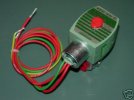- Joined
- Feb 28, 2006
- Messages
- 3,494
Hi Guys,
I'm trying to round up a couple of gas solenoids. Where do you all get them for a reasonable price. Would this one on ebay work, http://cgi.ebay.com/ws/eBayISAPI.dll?ViewItem&ssPageName=STRK:MEWAX:IT&item=7620052794? Here's the merchant's description: "Valve Gas Pilot Solenoid 3/8" 15# 120V Asco. Part No. 238110030501/330026."

Thanks, Phil
I'm trying to round up a couple of gas solenoids. Where do you all get them for a reasonable price. Would this one on ebay work, http://cgi.ebay.com/ws/eBayISAPI.dll?ViewItem&ssPageName=STRK:MEWAX:IT&item=7620052794? Here's the merchant's description: "Valve Gas Pilot Solenoid 3/8" 15# 120V Asco. Part No. 238110030501/330026."
Thanks, Phil


